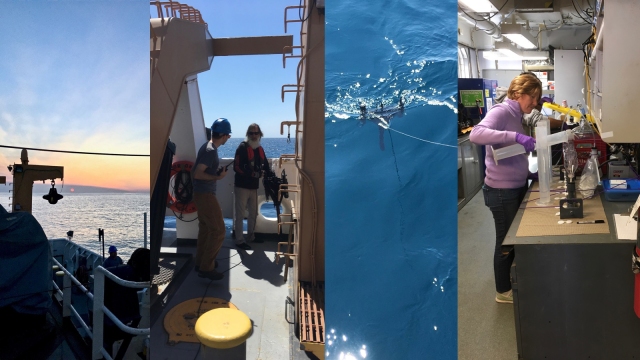Monday 27 August 2018
We had a very productive week end sampling on Georges Bank. The wind, sea, and sky were cooperative allowing us to conduct a lot of science. The satellite oceanographers were able to collect data every day in conjunction with overpasses of the NOAA satellites. We were able to sample about a third of the bongo and half the CTD stations on Georges Bank. The sea bird observers have been seeing dolphins, mostly Risso’s and Common, White-faced Storm Petrels, Skulas, and a Yellow Warbler that has made a temporary stop on the ship.

Two-inch witch flounder larvae caught in a bongo net. Witch flounder larvae stay in the water column longer, and grow to larger sizes, than many other larval fish. This individual is still metamorphosing from larvae to early-juvenile, when it will be ready to settle to the ocean bottom. The eye on the top of the head has not fully rotated from the left to the right side yet. Photo credit: NOAA Fisheries/Harvey Walsh

Clear skies and calm seas make for good satellite oceanography data collection. Sunrise over Georges Bank indicates another good day for light and water sampling (left). Jeff (front) and Charles (back) communicate with the bridge before deploying the radiometer (left/center). The radiometer collects light data with sensors that look both up towards the sky and down into the water (right/center). This will allow for data to be matched with what the satellites are recording as they pass over our station. Other researchers like Audrey are collecting data on phytoplankton by filtering water for analysis back in the lab and instruments that image the plankton and measure the size of the cells (right). Photo credits: NOAA Fisheries/Harvey Walsh
We our back in the Southern New England (SNE) region this morning. We are sampling off Fire Island, New York and around the travel lanes into the Hudson River. We hope to finish the SNE stations early Tuesday morning, then start zig-zagging our way down to Chesapeake Bay.

An example of the different phytoplankton sampled so far on our cruise. The Imaging FlowCytobot (IFCB) is sampling water continually along our cruise track from the ship’s scientific flow-through seawater system.
So far, we have completed 37 bongos and 11 CTDs.
Harvey Walsh
Chief Scientist
GG180-04 Ecosystems Monitoring Survey
Editor’s Note: Check out NOAA Teacher at Sea Martha Loizeaux’s blog for her experiences during the EcoMon survey.
